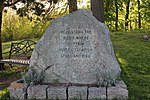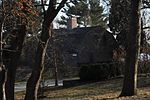Clark's Island
Coastal islands of MassachusettsIslands of Plymouth County, MassachusettsPlymouth, MassachusettsPlymouth County, Massachusetts geography stubs

Clark's Island is the name of a small island located in Duxbury Bay in the U.S. state of Massachusetts. It was named for John Clark, the first mate of the Mayflower, the ship that brought the Pilgrims to New England. The island was initially considered for the location of the Pilgrim's settlement, but was rejected in favor of a site to the south, which became known as Plymouth, Massachusetts. Today Clark's Island is a part of the town of Plymouth.
Excerpt from the Wikipedia article Clark's Island (License: CC BY-SA 3.0, Authors, Images).Clark's Island
Plymouth
Geographical coordinates (GPS) Address Nearby Places Show on map
Geographical coordinates (GPS)
| Latitude | Longitude |
|---|---|
| N 42.008333333333 ° | E -70.6375 ° |
Address
Fort Standish
Plymouth
Massachusetts, United States
Open on Google Maps








